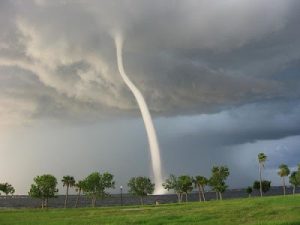Global severe convective storm activity in July resulted in another billion dollar plus bill for insurance and reinsurance capital to pay, as severe thunderstorm, tornado, hail, rainfall and wind caused by convective activity, resulted in over $1.3 billion of insured losses worldwide.
 In its latest monthly catastrophe recap report, Impact Forecasting the risk modelling and analytics arm of reinsurance broker Aon Benfield, highlights the continued build up of severe convective storm losses, which is one of the major causes of reinsurance firms rising catastrophe loss experience through the first-half of 2016.
In its latest monthly catastrophe recap report, Impact Forecasting the risk modelling and analytics arm of reinsurance broker Aon Benfield, highlights the continued build up of severe convective storm losses, which is one of the major causes of reinsurance firms rising catastrophe loss experience through the first-half of 2016.
Aside from the large one-off catastrophe losses seen in 2016, such as the Fort McMurray, Canada wildfire and the Kumamoto, Japan earthquake, the losses have been driven by severe convective storms and resulting tornado, hail, rain, flood and wind damage.
The U.S. has suffered the most, but severe convective storm losses have also been seen in Australia, Europe and South Africa so far this year.
In July 2016, the U.S. experienced six individual outbreaks of severe convective storm activity and flash flooding, covering a swathe from the Rockies to the East Coast. Resulting economic losses were minimally estimated at $1.5 billion.
Of this $1.5 billion, public and private insurance and reinsurance capital is estimated to be on the hook for around nearing $1 billion, or 67% of the overall economic costs, according to Impact Forecasting.
Hot and humid conditions over an extended period led to what is termed a “Ring of Fire” thunderstorm pattern across the U.S., a weather pattern that also elevated thunderstorm and flood activity, causing damage in the Canadian provinces of Alberta, Saskatchewan, Manitoba, Ontario, and Quebec. Economic and insured losses in Canada are expected to be significantly above $100 million once all assessments are completed.
July also saw severe thunderstorms and flash flooding in South Africa, killing at least seven people and providing the local insurance industry with a loss expected to exceed $145 million, with the economic toll much higher.
However, while the toll from global convective storm losses has hurt the insurance and reinsurance industry, and caused losses to some ILS funds and reinsurance sidecars, in 2016, it pales in comparison to the economic impact of flooding in China.
China suffered substantial seasonal “Mei-Yu” rainfall causing already bad flooding conditions along the Yangtze River Basin to worsen and further floods in China’s northeast. Data from China’s Ministry of Civil Affairs shows that a combined 764 people were left dead or missing, and more than 800,000 homes and other structures damaged or destroyed, while an estimated 18 million acres of agricultural cropland was damaged by floodwater.
Total combined economic losses are estimated at $33 billion, according to Impact Forecasting, with at least $28 billion of those emanating from the Yangtze River Basin.
However, despite the huge scale of the economic loss costs, just 2% of the total is estimated to have been covered by insurance, with the majority of claims payouts said to be from lost agriculture.
Once again this highlights the enormous insurance protection gap in China and the potential for insurance and reinsurance capital to greatly assist in providing protection to lives and livelihoods of the people in these devastated regions.
Adam Podlaha, Global Head of Impact Forecasting, commented; “While it was expected that China would see above normal rainfall during the peak monsoon months with such a strong El Niño, the intensity and scope of what transpired from the associated floods were at a magnitude not seen in nearly two decades. The flood peril is one which is becoming better understood by catastrophe modelers, and the industry is better prepared than ever to help create awareness of the risks associated with such large events.”
Other events of note that hit around the world in July include:
- Monsoon rains also led to extensive flood damage elsewhere in Asia. More than 230 people were left dead or missing in India, Nepal, Pakistan, Indonesia and Afghanistan as tens of thousands of homes were destroyed.
- Super Typhoon Nepartak claimed 82 lives as it made separate landfalls in Taiwan and China. Though not officially coming ashore, its outer bands lashed northern portions of the Philippines. The heaviest damage was noted in Taiwan and China, where at least 38,000 homes were damaged or destroyed. Combined economic losses were at least USD1.5 billion.
- Tropical Storm Mirinae made separate landfalls in southern China and northern Vietnam, leaving at least five people dead or missing. The storm left more than 2,000 homes and 110,000 hectares (272,000 acres) of cropland damaged or destroyed. Total combined economic losses were listed at USD20 million.
- The Sand Fire was ignited in California, charring more than 41,432 acres (16,770 hectares) of land. Two people were killed as the fire damaged or destroyed more than 140 homes and other structures.
The full July catastrophe recap report can be downloaded in PDF format here.
 View all of our Artemis Live video interviews and subscribe to our podcast.
View all of our Artemis Live video interviews and subscribe to our podcast.
All of our Artemis Live insurance-linked securities (ILS), catastrophe bonds and reinsurance video content and video interviews can be accessed online.
Our Artemis Live podcast can be subscribed to using the typical podcast services providers, including Apple, Google, Spotify and more.































